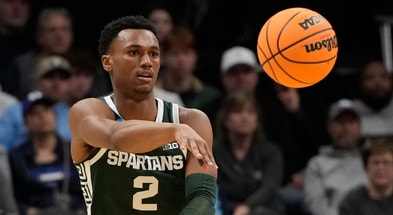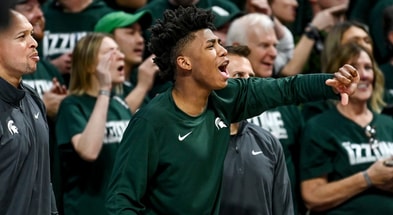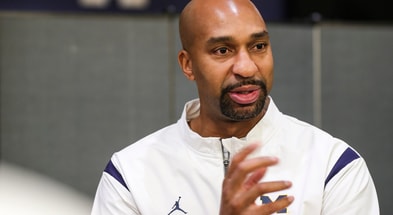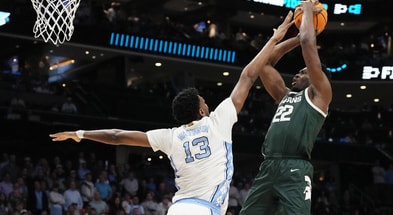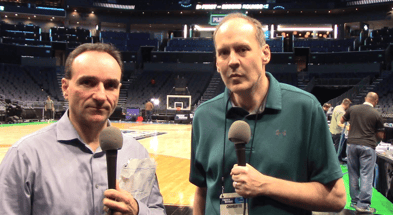Three Things to Watch: Michigan State vs. Rutgers
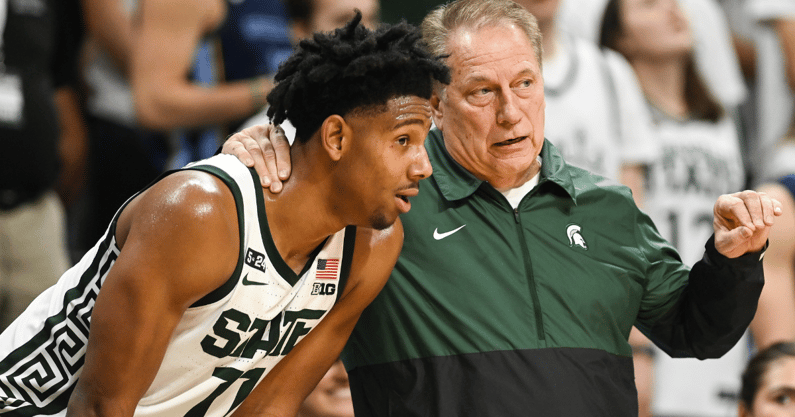
East Lansing, Mich. – After losing back-to-back games against Illinois, the most talented team in the Big Ten, and Purdue, the best all-around team in the Big Ten, Michigan State (12-6, 4-3) is preparing for a Thursday match-up with No. 23 Rutgers (13-5, 5-2), which is the most physical team in the Big Ten. This game will test the mental toughness and resolve of the the Spartans as much as any to date.
“It is going to be another rock fight,” Tom Izzo said on Tuesday afternoon. “Steve (Pikiell) is one of my favorite guys in the league because he coaches with passion and his kids are tougher than nails, and he coaches that way, a lot like Matt (Painter). They’ve got some veterans with (Paul) Mulcahy and (Clifford) Omoruyi. They’ve been playing together for three years. They’ve added a new guy who is a heckuva player. They’ve got size and speed. More size than anybody.”
Continue reading for Three Things to Watch in Michigan State’s game against Rutgers.
1. Fatigue is a major concern for Michigan State
Michigan State is playing its fourth game in 10 days, while Rutgers is playing its second game during the same span. Fatigue is a major concern for the Spartans, who have struggled to close out games since Malik Hall went down with an injury in the second half at Illinois.
With a shorter bench, and starters playing heavy minutes, Michigan State has been forced to alter its practice plan for Rutgers in effort to save legs. The Spartans have been through this before while playing the second half of a brutal non-conference schedule without Hall and Jaden Akins.
The difference between then and now, however, is the physicality of the basketball being played.
“We’ve been there and done that,” senior forward Joey Hauser said. “We went out to Portland with Jaden and Malik down and played minimal guys in three games and however many days it was. Now that we are in the Big Ten it is going to be even harder just because of the physicality of the games. We just have to take care of our bodies. The coaching staff is going to be smart about how we are doing stuff. It’s going to be a lot of mental prep work and a day-by-day thing.”
No team in the Big Ten is more physical than Rutgers.
2. Can Michigan State sustain a rhythm in a half-court game?
Rutgers leads the Big Ten in scoring defense in conference games (61.6), with Michigan State not far behind, allowing 63 points per game. The Spartans have played several of the Top 5 scoring defenses in the Big Ten already, including Purdue (63.9), Illinois (66.1), and Wisconsin (67.5). None of those previous opponents are as good defensively as Rutgers, which features top-shelf backcourt defenders, along with an elite rim protector in center Cliff Omoruyi (6-11, 240, Jr., Benin City, Nigeria, Roselle Catholic).
With tired legs, less prep time than Rutgers, and without its most most versatile defender in Hall, Michigan State is unlikely to be as good defensively as its stats would indicate. Rutgers, meanwhile, is daisy fresh with the defensive personnel and depth to give the Spartans fits in a halfcourt game. Michigan State could find it difficult to sustain any type of rhythm on offense against Rutgers.
Scoring could be as tough to come for the Spartans as it was in a low-scoring win over Michigan. The difference between that game, however, and this will be in the number of open looks Michigan State gets. Against the Wolverines, Michigan State got the looks it wanted on offense, but had a cold shooting day. In this game, Rutgers will contest everything.
The size and physicality of the Scarlet Knights is such that opponents are prone to stretches of poor play. Against Rutgers, good decision-making is vital. Spartan guards must take care of the ball and make accurate passes. Tyson Walker, AJ Hoggard, and Jaden Akins need to be decisive coming off ball screens and take what the defense gives them. This is unlikely to be a game where Hoggard or Walker can score at the rim without being challenged.
For Michigan State to have sustained success on offense against Rutgers, Walker, Hauser, Akins, and Hoggard must make contested shots. There will not be many opportunities in this game for the Spartans to turn down good shots for a great shots. This is also a game where not having a reliable post scoring option could prove especially problematic.
Rutgers features two of the best all-round defenders in the Big Ten. Caleb McConnell (6-7, 200, Sr., Jacksonville, FL, Spire Academy) is the league’s reigning Defense Player of the Year. Loyola (MD) University transfer Cam Spencer (6-4, 207, Jr., Davidsonville, MD) has as many steals as Walker, Hoggard, and Akins combined.
Spencer ranks second in the Big Ten in steals (2.6), with McConnell (2.3) third despite only playing in 13 games this season. Point guard Paul Mulcahy (6-7, 200, Sr. Bayonne, NJ, Gill St. Bernard’s) also ranks among the Big Ten leaders in steals.
Over-dribbling could be disastrous against Rutgers. This game will test Hoggard’s patience as well as his ability to balance roles as a facilitator and an end-of-shot clock scorer. Hoggard is good at getting into the lane and creating for himself at the rim late in the shot clock. With Omoruyi protecting the rim and McConnell playing elite on-ball defense, some of Hoggard’s tricks may not work as well against Rutgers.
If Michigan State had better depth and elite frontcourt rebounders, the Spartans would be better equipped to supplement their halfcourt offense with transition scoring.
“We’re trying to run, and that’s a big part of our offense,” Izzo said. “But as you can see, we’re not running as good either. One reason is that we are putting everything into our (defensive) rebounding and we are plus eight or nine in the league, which is amazing. When you don’t score on the break, you’re offense is never as good.”
3. Rutgers has no superstar, but plenty of weapons
Rutgers is a program built on defense, rebounding, and physicality. Given those staples, it should come as no surprise that Rutgers is in a lot of close games. In contrast to an offense-minded Big Ten team like Iowa, Rutgers doesn’t need to score a certain number of points to offset deficiencies on defense.
Top 10
- 1
A Twisted Mess
Big 12 Championship scenarios
- 2Trending
Saban chirped
Big 12 comes after GOAT
- 3Hot
Underranked SEC
Lane Kiffin protests CFP rankings
- 4
UConn star hospitalized
Alex Karaban hospitalized at Maui Invitational
- 5
DJ Lagway
Fan flashes Florida QB to Pope
That doesn’t mean, however, that the Scarlet Knights lack the firepower on offense to put a hole in anyone on their schedule under certain circumstances, and in this case tired legs. Rutgers has a solid collection of interchangeable pieces that can be utilized to exploit the defensive weaknesses of its opponent.
Spencer leads Rutgers in scoring (13.9). He is a rugged competitor and capable defender. He is also a lethal catch-and-shoot scorer from behind the 3-point line. Spencer leads Rutgers in made threes (42), 3-point field-goal percentage (46.7), assists (2.7), and steals (2.6) per game. He has made a lot of threes, but he doesn’t hunt them. Spencer is, however, willing to make tough shots and bury contested jumpers when needed.
Spencer and Omoruyi are the only Rutgers players averaging double figures, but they aren’t the only scoring threats. McConnell is a slippery, and can create for himself or others. McConnell is averaging 9.8 points and 2.4 assists per game as a senior.
Mulcahy is averaging just 8.6 points per game this season, but he is one of the better penetrating guards in the Big Ten, and Michigan State has struggled to keep him out of the paint. He knows how to finish around the basket, and he also knows where to go with the ball when defenses collapse on him.
Omoruyi might be the best all-around athlete in the Big Ten. Omoruyi ranks second in scoring average (13.2) for Rutgers and leads his team in field-goal percentage (48.7), rebounding average (10.1), and blocked shots (2.0) per game. Omoruyi does most of his damage around the rim. He will shoot an occasional perimeter jumper.
Starting forward Mag Mowat (6-7, 216, Jr., Melbourne, Australia, Prolific Prep) is one of the best athletes on one of the more athletic rosters in the Big Ten. Mowat, who is averaging 7.6 points and 5.4 rebounds per game, is a dangerous role player for the Scarlet Knights.
Michigan State has three very good defensive guards in Walker, Hoggard, and Akins, but the Spartans haven’t faced a collection of big, athletic guards in conference play that they’ll face against Rutgers. Then there’s Omoruyi, who is as athletic as any center that has played in the Big Ten in recent memory.
Center Mady Sissoko is going to have has hands full with Omoruyi. Rutgers has a decided advantage at the position. Neither program can afford foul trouble to its starting center.
“Their guards are 6-5, 6-7, and 6-8,” Izzo said. “It’s kind of like a bunch of 6-7 guys, and then Omoruyi, who is a beast and maybe the most athletic guy in the league.”
The five, however, isn’t the only position for Michigan State where foul trouble could be problematic. With Hall sidelined by injury, the Spartans will be asking Hauser to exert a great deal of energy on defense. Keeping Hauser out of foul trouble in this game is a critical priority. If Hauser isn’t in the game, Michigan State run into problems on the glass and with offensive spacing. There isn’t a path to victory for the Spartans in this match-up if Rutgers is able get a high percentage of offensive rebounds on missed shots.












